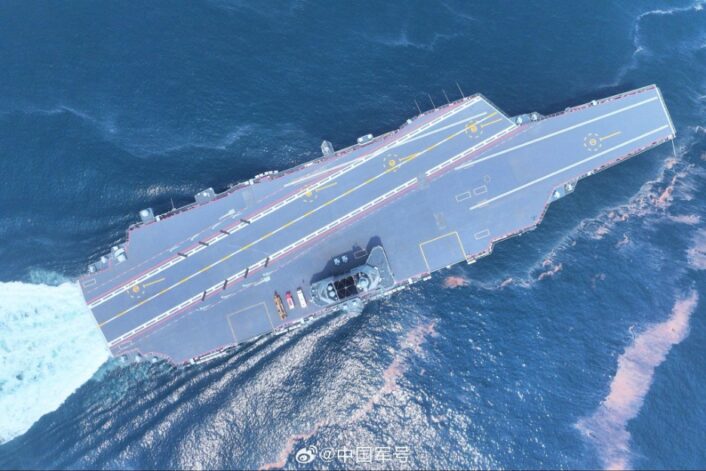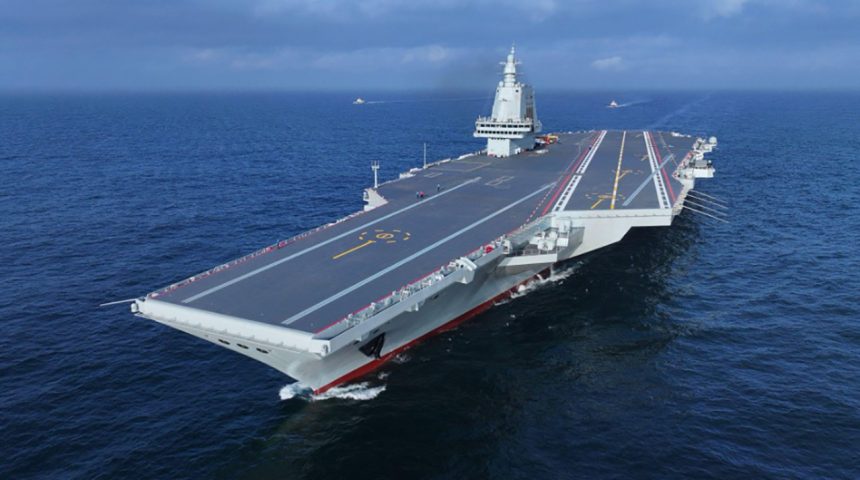Chinese media estimates that the supercarrier’s weapons and flight tests of aircraft too will be conducted over the next year, possibly alongside the sea trials
The first high-resolution images of China’s fourth aircraft carrier were released, as the flat-top concluded its first eight-day sea-trials. The warship looked majestic with the colors of its steel superstructure and flight deck sharply visible, as against the open source images on social media when it left Jiangnan shipyard’s pier in the Yangtze river’s delta on April 29, 2024. The ship moored out under its own power, while being assisted by several tugboats.
Handle ‘sugar_wsnbn’ on X (formerly Twitter) said the Fujian conducted “tests on its driveline and power systems,” and “will continue (scheduled) test operations,” possibly over the next year. Before the Fujian set out for sea trials, it underwent comprehensive mooring and equipment calibration trials.
5月8日午後、空母福建は8日間に渡る1度目の試験航海を完了し江南造船所の埠頭に戻った。
試験航海にて福建は動力系や電力システム等の試験を実施した。福建は今後も予定通り試験作業を継続する。
(via 中国军号) pic.twitter.com/mem8gDAr1G
— お砂糖wsnbn (@sugar_wsnbn) May 8, 2024
The current stage involves thoroughly testing and running the ship’s propulsion, electrical, power generation, fire suppression, communication, navigation and various electronics under various conditions and scenarios to validate their performance. The practice determines that the vessel is fit for basic sea-going state, if not for regular combat duties.
Next Stage – Flight Trials & Weapons Tests
The next stage in the carrier’s test will include flight trials of J-15 and possibly the J-31/J-35, where its Electro-Magnetic Launch System (EMALS)-powered catapult will launch and retrieve the fighters. Going by the schedule of earlier Chinese carriers like the Liaoning and the Shandong, this process is likely to commence by next year, possibly between early to mid-2025.
In south Asian and Indian Navy parlance, the stages are described as the “work-up” phase. Here, ship management, operational procedures and emergency procedures are finalized. The commissioning crew fully verifies the performance parameters of the vessel’s systems that they oversaw during the construction and outfitting stage. Any issues and required repairs and modifications are undertaken when the vessel goes back to the shipyard.
Global Times however estimated an ambitious timeline that involved flight trials to also be concurrently wrapped over the next year along with the sea sailing trials. “In the coming months, the carrier will conduct several sessions of sea trials and test more complicated operational components, including electromagnetic compatibility, weapons systems, as well as takeoffs and landing of aircraft.”

The weapons trials will meanwhile involve testing the ship’s Close-In Weapons Systems (CIWS) like the Type-730 gatling gun and what appears to be the HQ-10 point missile defense system. Two of each of the two systems are seen on the port-side – two near the bow and two near the stern.
These would be tested with the ship’s Active Electronically Scanned Array (AESA) radar and fire control systems, checking if target acquisition and engagement fusion and procedures by gunnery crews are working in tandem.
Nice Video
— Mario Honschek (@hotelhons) May 8, 2024
The advanced stages would involve using the weapons against pilotless target drones. The systems are the ship’s last line of defense against incoming anti-ship ballistic and cruise missiles, after projectiles have managed to evade other defenses by surrounding destroyers and frigates, part of the carrier battle group (CBG).
Largest & Most Advanced Chinese Carrier
The Liaoning and the Shandong displace about 60,000 tons each and use a ski-jump ramp to launch aircraft given their short-take-off barrier-arrested (STOBAR) configuration. Planes taking off have to do so on their own power.
The Fujian in comparison displaces 80,000 tons, while its EMALS allows it to launch aircraft with their full payload capacities, and also release heavier planes like the KJ-600 Airborne Early Warning and Control (AWACS).
Beside advanced versions of the J-15, and the next-generation J-31/J-35 stealth fighter, it is also expected to operate the JL-10 advanced jet trainer. This could possibly be a naval variant with a stronger landing gear and arrestor hooks to be operated from carriers. Combined with the Shandong and Liaoning, the carrier strengthens China’s additional line of defense beside the long-range anti-access/area-denial weapons led by the DF-21D anti-ship ballistic missile.
The J-15 variants might include the J-15B, a version designed to be launched by steam and EMALS-powered CATOBAR. The original J-15, a Chinese-made analogue of the Russian Su-33 Flanker, can also take off from STOBAR ski-jump-configured carriers like the Liaoning and the Shandong. The J-15B is therefore expected to be Fujian’s frontline fighter aircraft, given it can carry more weight and is heavier and larger than the stealth J-31/J-35. The lighter J-31/J-35 might be restricted from carrying external loads with a view to not compromise its stealth.
A ‘teaming’ pair between the J-15B, the electronic-warfare-centric J-15D and the J-35 can be expected, where the J-35 undertakes the stealthy radar surveillance roles. The J-15 might act as the missile truck, releasing missiles at targets identified by J-35 and the J-15D. The J-15D is China’s version of the US Navy’s EA-18G Growler.









